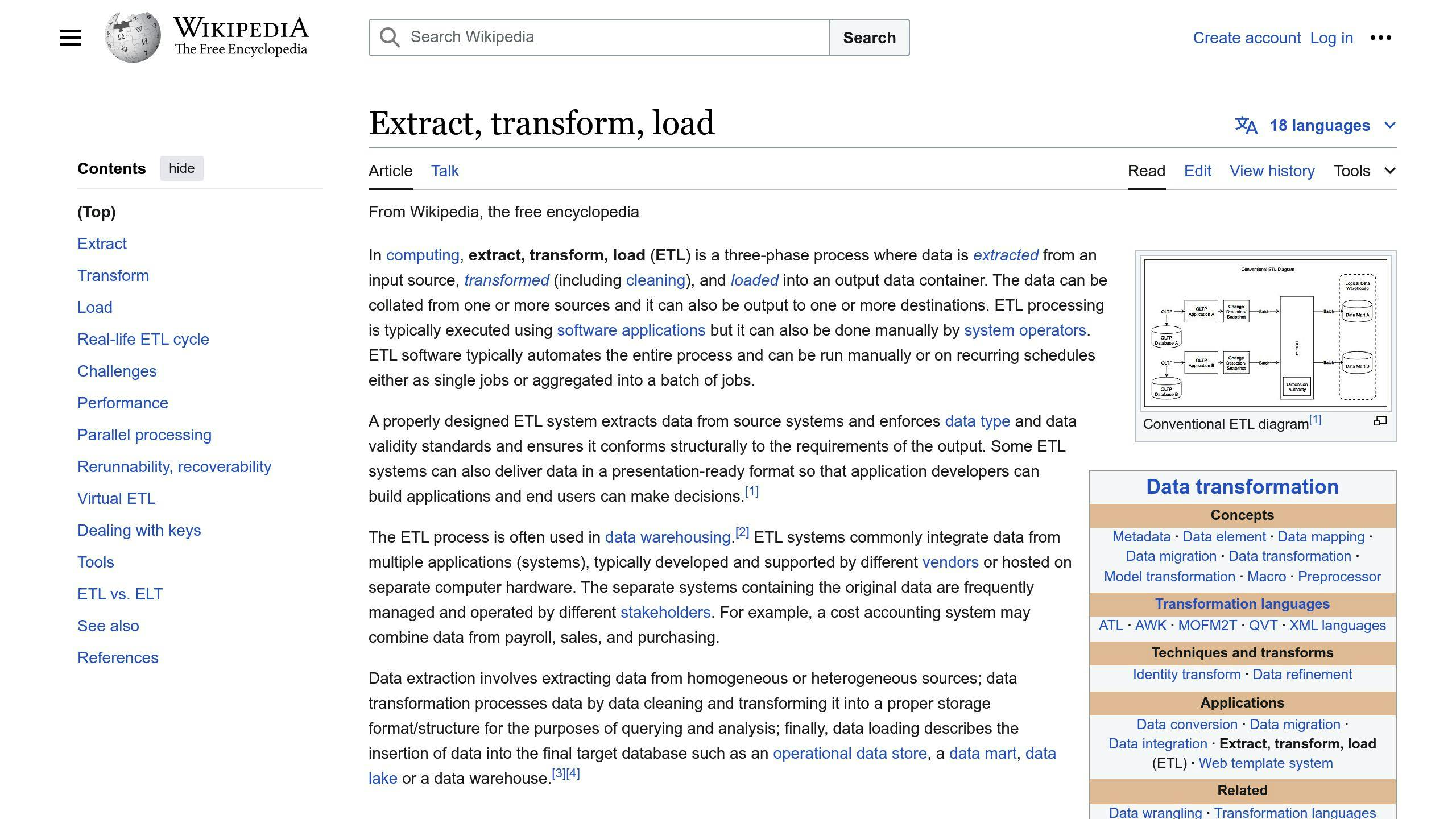ETL (Extract, Transform, Load) and ELT (Extract, Load, Transform) are two different approaches to data integration. Here's a quick overview:
ETL:
- Data is extracted from sources
- Transformed on a separate server
- Then loaded into the target system (data warehouse)
ELT:
- Data is extracted from sources
- Loaded directly into the target system (data warehouse)
- Transformed within the target system using its processing power
| Criteria | ETL | ELT |
|---|---|---|
| Order of Operations | Extract, Transform, Load | Extract, Load, Transform |
| Data Latency | Higher | Lower |
| Flexibility | More controlled transformations | More flexible for diverse data |
| Complexity | Better for complex transformations | Simpler loading, robust warehouse tools needed |
| Use Cases | Legacy systems, smaller datasets, high security needs | Cloud environments, large data volumes, diverse data types |
| Speed | Slower due to staging and transformations | Faster initial loading, transformation speed varies |
| Data Security | Enhanced due to controlled transformations | Depends on warehouse security measures |
| Maintenance | Requires maintaining ETL server and processes | Primarily maintaining the data warehouse |
When to Use ETL:
- Legacy systems and smaller datasets
- High data security needs
- Complex data transformations
- Historical data visibility is crucial
When to Use ELT:
- Modern data warehouses and cloud environments
- Large data volumes and high velocity
- Diverse data types (structured and unstructured)
- Changing analytics requirements
The choice between ETL and ELT depends on factors like data volume, complexity, speed requirements, security needs, and existing infrastructure. As data needs evolve, new approaches like ETLT (Extract, Transform, Load, Transform) and cloud-native data integration platforms are gaining traction.
Related video from YouTube
Key Differences Between ETL and ELT

Process Order
The main difference between ETL and ELT lies in the order of their processes:
- ETL: Extract, Transform, Load - Data is extracted, transformed, then loaded into the target system.
- ELT: Extract, Load, Transform - Data is extracted, loaded into the target system, then transformed.
Where Transformations Occur
ETL transforms data on a separate server before loading into the target system. ELT performs transformations within the target system itself, using its processing power.
Data Speed and Latency
- ETL: Generally has higher data latency due to the intermediate transformation step, slowing down the loading process.
- ELT: Reduces latency by loading data directly into the target system, enabling faster data loading. However, transformation speed depends on the target system's capabilities.
Flexibility and Complexity
| ETL | ELT |
|---|---|
| Offers a more controlled transformation process | Simpler data loading process |
| Suitable for complex data integrations | Requires robust warehouse tools for complex transformations |
| Less flexible | More flexible for diverse data types and changing requirements |
Maintenance and Costs
- ETL: Requires maintenance of the ETL server and transformation processes, which can be time-consuming and costly.
- ELT: Primarily focuses on maintaining the data warehouse and its transformations, which can be more cost-effective, especially with cloud-based solutions.
Comparison Summary
| Category | ETL | ELT |
|---|---|---|
| Definition | Data is transformed before being loaded | Data is loaded and then transformed |
| Order of Operations | Extract, Transform, Load | Extract, Load, Transform |
| Processing Environment | Transformation on a separate server | Transformation within the data warehouse |
| Data Latency | Higher | Lower |
| Flexibility | More controlled transformation process | More flexible for diverse data types |
| Complexity | Can be intricate for complex data integrations | Simpler loading process, robust warehouse tools needed for complex transformations |
| Use Cases | Ideal for legacy systems, smaller datasets, high data security needs | Best for cloud-based environments, diverse data types |
| Speed | Might be slower due to staging and transformation | Faster initial loading, transformation speed varies |
| Privacy | Enhanced data security due to controlled transformation | Depends on warehouse security measures |
| Maintenance | Requires maintenance of ETL server and processes | Primarily focuses on maintaining the data warehouse |
From ETL to ELT
ETL Background
ETL (Extract, Transform, Load) has been used for data integration since the 1970s. It involves:
- Extracting data from various sources
- Transforming the data into a standard format
- Loading the transformed data into a target system like a data warehouse
ETL enabled businesses to analyze data from different sources in one place.
ETL Challenges
However, traditional ETL processes faced some issues:
- High costs, especially for large datasets
- Inflexibility in adapting to changing needs
- Scalability problems leading to increased latency and decreased performance
Rise of ELT
The growth of cloud computing and modern data warehouses led to ELT (Extract, Load, Transform). ELT uses the target system's processing power for transformations.
ELT emerged due to the need for:
- Greater flexibility
- Better scalability
- Cost-effectiveness
ELT Benefits
ELT offers several advantages over ETL:
- Reduced latency by loading data directly into the target system
- Greater flexibility in adapting to changing requirements
- Cost-effectiveness, especially with cloud-based solutions
With ELT, organizations can focus on analyzing data instead of spending resources on data integration.
| Comparison | ETL | ELT |
|---|---|---|
| Data Loading | Data is transformed before loading | Data is loaded and then transformed |
| Transformation Location | Separate server | Within the target system |
| Data Latency | Higher | Lower |
| Flexibility | More controlled transformation process | More flexible for diverse data types |
| Complexity | Can be complex for intricate integrations | Simpler loading, robust warehouse tools needed for complex transformations |
| Use Cases | Ideal for legacy systems, smaller datasets, high security needs | Best for cloud-based environments, diverse data types |
| Speed | Slower due to staging and transformation | Faster initial loading, transformation speed varies |
| Data Security | Enhanced due to controlled transformation | Depends on warehouse security measures |
| Maintenance | Requires maintaining ETL server and processes | Primarily maintaining the data warehouse |
sbb-itb-d1a6c90
When to Use ETL or ELT
ETL Use Cases
ETL is the better choice in these situations:
1. Legacy Systems and Smaller Datasets
If your company uses older systems or deals with smaller amounts of data, ETL can work well. ETL is good for structured data formats and allows for detailed transformations before loading data into the target system.
2. High Data Security Needs
When handling sensitive data or operating in highly regulated industries, ETL's controlled transformation process can offer better security. By removing or masking sensitive information before loading data into the target system, ETL helps prevent data breaches and ensures compliance with privacy rules.
3. Complex Data Transformations
If your data integration process involves diverse data sources and requires complex transformations, ETL can be advantageous. ETL allows for customized data cleansing, validation, and harmonization before loading, ensuring data consistency and quality.
4. Historical Data Visibility
In scenarios where historical data visibility is crucial, ETL can provide a comprehensive audit trail and historical tracking of data changes. By capturing and logging transformation activities, ETL enables detailed insights into business processes and stakeholder relationships.
ELT Use Cases
ELT is the better choice in these situations:
1. Modern Data Warehouses and Cloud-Based Environments
If your company operates with modern data warehouses or cloud-based infrastructures, ELT can leverage their scalability and processing power. ELT is well-suited for cloud-based solutions like Snowflake, BigQuery, or Databricks, where transformations can be performed within the target system.
2. Large Data Volumes and High Velocity
ELT excels in handling large volumes of data and high-velocity data streams. By loading data directly into the target system, ELT reduces latency and enables faster data ingestion, making it ideal for real-time analytics and decision-making.
3. Diverse Data Types (Structured and Unstructured)
ELT's flexibility allows for the integration of both structured and unstructured data types. If your company deals with diverse data formats, such as text, images, or videos, ELT can accommodate these without the need for upfront transformations.
4. Changing Analytics Requirements
If your company's analytics and reporting requirements are dynamic and evolving, ELT can provide greater agility. By preserving raw data in the target system, ELT allows for iterative transformations based on changing analytical needs and queries.
Choosing ETL or ELT
When deciding between ETL and ELT, consider these critical factors:
-
Infrastructure and Existing Systems: Evaluate your company's existing infrastructure and systems. If you operate with legacy systems or on-premises databases, ETL may be a better choice. However, if you have adopted modern cloud-based data warehouses or big data platforms, ELT can be more advantageous.
-
Data Volume and Velocity: Assess the volume and velocity of your data. If you deal with large amounts of data or high-velocity data streams, ELT's ability to leverage the scalability and parallel processing capabilities of modern data warehouses can be beneficial.
-
Data Security and Compliance Requirements: If data privacy and security are paramount, a controlled ETL process can offer added peace of mind by removing or masking sensitive information before loading data into the target system.
-
Transformation Complexity: Evaluate the intricacies of the required transformations. If your data integration process involves complex, multifaceted transformations, ETL may be better suited. However, if the transformations are more straightforward, ELT can handle them within the target system.
-
Cost Implications: Consider the potential costs associated with dedicated transformation servers (for ETL) versus modern data warehousing solutions (for ELT). Cloud-based ELT solutions can be more cost-effective, especially for large data volumes.
Ultimately, the choice between ETL and ELT should align with your company's specific needs, infrastructure, and long-term data goals. By carefully evaluating these factors, you can pave the way for efficient, insightful, and future-proof data integration.
Future Trends
New Data Integration Approaches
As data needs evolve, new approaches to data integration are emerging. One example is ETLT (Extract, Transform, Load, Transform), which combines ETL and ELT. ETLT allows for near real-time data extraction and transformation, while also enabling additional transformations within the target system. This approach can lead to faster data integration, improved data quality, and enhanced analytics capabilities.
Another trend is the growing adoption of cloud-native data integration platforms. These platforms offer scalability, flexibility, and cost-effectiveness. They enable organizations to integrate data from diverse sources, transform and process data in real-time, and load it into cloud-based data warehouses or lakes.
Advancements in Data Warehousing
Modern data warehouses, such as Snowflake, BigQuery, and Databricks, are shaping the future of data integration. These platforms provide scalable, high-performance, and secure environments for data integration and analytics. They allow organizations to handle large volumes of data, perform complex transformations, and support real-time analytics and machine learning workloads.
Cloud-based data lakes, like Amazon S3 and Azure Data Lake, are also gaining popularity. These centralized repositories store and process large amounts of structured and unstructured data. Data lakes enable organizations to integrate data from diverse sources, perform data exploration, and support advanced analytics and machine learning use cases.
Staying Ahead
As data integration evolves, organizations must stay up-to-date with new trends, technologies, and approaches. By understanding emerging trends and advancements, organizations can develop a future-proof data integration strategy that meets their growing data needs.
| Trend | Description |
|---|---|
| ETLT | Combines ETL and ELT, enabling near real-time data extraction, transformation, and additional transformations within the target system. |
| Cloud-native Data Integration Platforms | Offer scalability, flexibility, and cost-effectiveness for integrating data from diverse sources, transforming and processing data in real-time, and loading it into cloud-based data warehouses or lakes. |
| Modern Data Warehouses | Provide scalable, high-performance, and secure environments for data integration and analytics, handling large volumes of data, performing complex transformations, and supporting real-time analytics and machine learning workloads. |
| Cloud-based Data Lakes | Centralized repositories for storing and processing large amounts of structured and unstructured data, enabling data integration from diverse sources, data exploration, and advanced analytics and machine learning use cases. |
Conclusion
Key Points
In this article, we looked at the key differences between ETL and ELT processes for data integration. We discussed:
- The traditional ETL approach, where data is extracted, transformed, and then loaded into a target system.
- The modern ELT approach, where data is extracted, loaded directly into the target system, and then transformed.
We also explored emerging trends in data integration, such as:
- ETLT: Combining ETL and ELT, allowing for near real-time data extraction, transformation, and additional transformations within the target system.
- Cloud-native Data Integration Platforms: Offering scalability, flexibility, and cost-effectiveness for integrating data from diverse sources, transforming and processing data in real-time, and loading it into cloud-based data warehouses or lakes.
- Modern Data Warehouses: Providing scalable, high-performance, and secure environments for data integration and analytics.
- Cloud-based Data Lakes: Centralized repositories for storing and processing large amounts of structured and unstructured data.
Final Thoughts
When choosing between ETL and ELT, it's crucial to evaluate your organization's specific needs and requirements. Consider:
| Factor | Description |
|---|---|
| Data Volume and Complexity | The volume and complexity of your data, including structured and unstructured formats. |
| Speed and Latency | The speed and latency requirements for your data integration and analytics processes. |
| Flexibility and Scalability | The level of flexibility and scalability you need to adapt to changing data needs. |
FAQs
What's the main difference between ETL and ELT processes?
In ETL, data is transformed on a separate server before loading into the target system. With ELT, raw data is loaded directly into the target data warehouse, and transformations happen within the warehouse itself.
When should I choose ETL or ELT?
ELT is faster than ETL for large data volumes. ETL has an extra transformation step before loading, which slows down as data size increases. ELT loads data directly into the destination and transforms it in parallel.
Use ETL for smaller datasets requiring complex transformations. Use ELT for massive structured and unstructured data.
When might I use ELT over ETL for data ingestion?
Use ELT when dealing with large amounts of data. ETL works better with smaller datasets. ELT supports structured, unstructured, and raw data types. ETL requires structured, relational data formats.
Is Snowflake an ETL or ELT tool?
Snowflake supports both ETL and ELT processes. It works with popular data integration tools like Informatica, Talend, Tableau, and Matillion. New tools eliminate manual ETL coding and outsourced data cleansing.
What are 5 key differences between ETL and ELT?
| ETL | ELT |
|---|---|
| Best for smaller datasets | Best for large data volumes |
| Transforms data before loading | Loads raw data, then transforms |
| Works with on-premises and cloud data warehouses | Optimized for cloud data warehousing |
| Requires structured, relational data | Supports structured, unstructured, semi-structured, and raw data |
| Transformations on a separate server | Transformations within the target system |

![Thumbnail for: Marketplace Integration: Strategies, APIs, Platforms [2024]](https://mars-images.imgix.net/seobot/bizbot.com/6663a6870f868443fbd9ecc7-2e760a36d379e419d5ed87be721c7d75.png?auto=compress)
